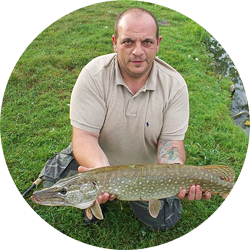aprile-maggio 2016
Sommario
TECNICA SPINNING
CRAW & CREATURE
di Renzo Della Valle
Spinning e bass fishing sono legati da due gruppi di esche molto efficaci in tutte le acque interne: le imitazioni di gambero e le fantasiose ‘creature’. Sono entrambe scelte ideali in tutte le occasioni in cui il pesce foraggio non ha ancora raggiunto il sottoriva.
ATTUALITÀ MOSCA
1° PESCARE SHOW FLY TYING EXPERIENCE
a cura della redazione
La foto di gruppo dei partecipanti alla manifestazione internazionale di costruzione testimonia l’atmosfera di grande affiatamento e di amichevole, appassionato scambio culturale che ha caratterizzato le due giornate vicentine.
TECNICA SPINNING
STREET FISHING A TORINO
di Davide Mazzesi
Il tratto cittadino del Po nella capitale subalpina ha molto da offrire allo street fisher. Davide, che per una volta scende dalle sue montagne per tornare sulle acque dove pesca sin da bambino, illustra i principali spot, tutti raggiungibili con i mezzi pubblici e poi a piedi.
ITINERARIO MOSCA
ADIGE, FIBBIO & C.
di Matteo Menghini
Una rassegna dei principali tratti delle acque in concessione all’A.P.P.V., Associazione Pescatori della Provincia di Verona, ovvero di tutte le zone salmonicole del Veronese: il fiume Adige, il bacino del Fibbio-Antanello e i torrenti Tramigna e Alpone.
TECNICA SPINNING
SPINNING IN LAGHETTO: NOVITÀ E CONFERME
di Giorgio Montagna
Vecchi e nuovi artificiali che funzionano davvero nelle acque dei laghetti, nell’esperienza recente di Giorgio e del suo gruppo di amici: dai minnow ai rotanti, dai lipless ai ‘metallici’, fino agli ondulantini da Area Trout.
ITTIOLOGIA
IL TEGUMENTO E LA LIVREA DEI PESCI
di Luca Ciuffardi
Oltre all’elemento estetico – più o meno accattivante per il pescatore – la livrea rivela molto delle caratteristiche dei pesci, sia in relazione agli ambienti abitati, sia alle sue funzioni, spesso fondamentali per la sopravvivenza.
TECNICA SPINNING
BASS & JIG: THE EVOLUTION
di Luca Quintavalla
Tecniche e consigli per l’uso dei jig, artificiali che negli ultimi anni hanno acquistato sempre maggior diffusione nelle scatole dei pescatori di black bass, anche e soprattutto per la progressiva modulazione delle sue misure, fino ai recenti modelli ‘micro’.
ITINERARIO MOSCA
ISLANDA
di Armando Quazzo
In questa intervista ad Árni Baldursson emergono tutti i vantaggi della pesca al salmone in Islanda, con pesci di buona misura, non troppo difficili e in un ambiente che garantisce di trascorrere sempre delle memorabili vacanze di pesca. Attrezzatura e artificiali.
TECNICA SPINNING MARE
INCHIKU VS SOFT BAITS IN ADRIATICO CENTRALE
di Diego Bedetti
Prima parte dell’intervento di Diego che mette a confronto due tipologie di artificiali per la pesca dalla barca in Adriatico. In questo numero si parla di inchiku: pesci insidiabili, spot e avvicinamento, attrezzatura e tecniche.
ITINERARIO MOSCA
FRIULI. A PESCA NEL PAESE DEI TEMPORALI E DELLE PRIMULE
di Adriano Piazzesi
In Friuli l’acqua «domina incontrastata una scena fatta di magia e di concretezza, di modernità, talvolta ostentata come rito esorcistico contro la passata miseria, e di struggenti rimpianti per il tempo che se ne è andato per sempre».
TECNICA SPINNING
FLOAT TUBING
di Alessandro Stefani
Paragonata a com’era solo dieci anni fa, la pesca del black bass in belly boat ha subito un’incredibile evoluzione, non solo tecnologica. L’accresciuta sicurezza, la maggiore funzionalità e la possibilità di portare con sé più canne agevola sicuramente il pescatore nella sua azione.
COSTRUZIONE MOSCA - TENKARA
YAMAGATA-SENDAI KEBARI
di Paolo Trabucchi
Terza proposta di mosca da Tenkara da parte di Paolo. Si tratta questa volta di un modello che ha caratteristiche imitative che lo rendono più simile a quelli della pesca a mosca di tipo anglosassone, pur rimanendo un Kebari, adatto alla pesca sia di superficie, sia sommersa.
TECNICA SPINNING
TROTA LAGHETTO: PARLIAMONE BENE
di Alessandro Mirandola
I pescatori più esperti hanno spesso una considerazione negativa degli impianti di pesca sportiva, ma è innegabile che essi possano svolgere varie funzioni positive anche per un angler evoluto. Specie in ambienti curati e magari dedicati.
COSTRUZIONE MOSCA
CERVIDI
di Federico Renzi
Cervo, alce, capriolo, camoscio, caribou. In un unico articolo un’utile carrellata su caratteristiche comuni e differenze di questi materiali, fra i più utilizzati da sempre. Con tre mosche storiche e alcune tecniche di montaggio. 17 le mosche scelte fra le numerose inviate dai lettori.
AUTOCOSTRUZIONE
LIPLESS CRANKBAIT
di Moreno Bartoli
«La realizzazione di un lipless crankbait presenta una difficoltà costruttiva medio-alta, dovuta soprattutto alla creazione interna di due camere separate in cui alloggiare la zavorra vera e propria e il rattle, con la doppia funzione di bilanciare i pesi ed emanare frequenze sonore».
































